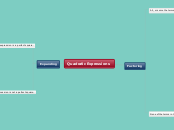по Hassan Mahad 8 лет назад
470
Quadratic Expressions

по Hassan Mahad 8 лет назад
470

Больше похоже на это
ANSWER: To expand this expression, you have to multiply the two binomials using the FOIL technique: Firsts Outers Inners Lasts EXAMPLE: (x + 3)(x + 5) After using the FOIL technique, you should come to the following terms: x2 + 5x + 3x + 15 Now, add like terms to get your answer: x2 + 8x + 15
ANSWER: Here we are dealing with a difference of squares. When you multiply the sum and difference of two terms, the two middle terms are opposite and add to zero. This is another special product pattern. EXAMPLE: (v+1)(v-1) Use the pattern for the product of a sum and difference . (v+1)(v-1) = (v)2-(v)2 = v2-v2
ANSWER: If you are able to recognize the pattern for squaring a binomial, you can expand it to the format of a2 + 2ab + b2. EXAMPLE: (m + 11)2 Use the appropriate pattern for squaring a binomial to expand. (m+11)2 = (m)2 + 2(m)(11) + (11)2 Simplify to get your answer. m2 + 22m + 121
ANSWER: The expression cannot be factored.
The trinomial is NOT a perfect square trinomial.
The trinomial is in the form of ax2 + bx + c (a≠1)
ANSWER: Find two integers whose product is a x c and whose sum is b. Then, break up the terms into groups and factor by grouping. EXAMPLE: 4x2+ 28xy + 49y2 The two integers whose product is (4)(49) and sum is (28) are 14 and 14. Now, break up the second term. 4x2 + 14xy + 14xy + 49y2 Factor by grouping to get your answer:
The trinomial is in the form of x2 + bx + c (a=1).
ANSWER: Find two integers whose product is c and whose sum is b. Then, express the quadratic expression as a product. EXAMPLE: x2 + 7x + 10 The two integers whose product is 10 and sum is 7 are 2 and 5. Now, take the integers and express them as a product. x2 + 7x + 10 = (x + 2)(x+5)
The trinomial is a perfect square trinomial. (NOTE: Verify that the trinomial is a perfect square by checking if a and c are perfect squares. Then, multiply both by 2, and if they are equal to b, you have a perfect square trinomial).
ANSWER: First, verify the the trinomial is a perfect square trinomial. Secondly, factor the trinomial as a2 + 2ab + b2 = (a + b)2. EXAMPLE: x2 + 20x + 100 Take a look at the terms x2 and 100. They are both perfect squares. √x2 + x √100 = 10 Now check if 2(10)(x) is equal to 20x. 2(10)(x) = 20x Now that we know this is a perfect square trionmial, we can factor it as a2 + 2ab + b2 = (a + b)2. x2 + 20x + 100 = (x)2 + 2(x)(10) + (10)2 = (x + 10)2
The expression is made up of monomials.
ANSWER: First, find the GCF of all the terns. Then, simply factor out the GCF to get your answer. EXAMPLE: 15w + 25z The GCF of 15 and 25 is 5. Divide both terms by 5 to get the following: 5(3w + 5z) NOTE: For polynomials with more than one variable, the GCF of the variable is the product of the common bases with the lowest exponent.
ANSWER: Here, you have to factor by grouping. To do this, factor groups of two terms with a common factor to produce binomials. Then, use the binomial common factor technique. EXAMPLE: mx + my + 2x + 2y Group mx + my into one group, and 2x = 2y in another. Then, find the GCFs of each group and factor accordingly. You should get the following: m(x + y) + 2(x+ y) Use binomial common factor to factor out (x+y). (x + y)(m + 2)
ANSWER: To factor a expression with two identical binomials, think of the binomial as a single term. The GCF will always be the binomial. Divide each term by the binomial to factor the expression. EXAMPLE: a(b+1) + 9c(b + 1) Think of (b+1) as a single term. The GCF is the binomial (b+1). Factor out this binomial to get the answer: (b+1)(a + 9c)